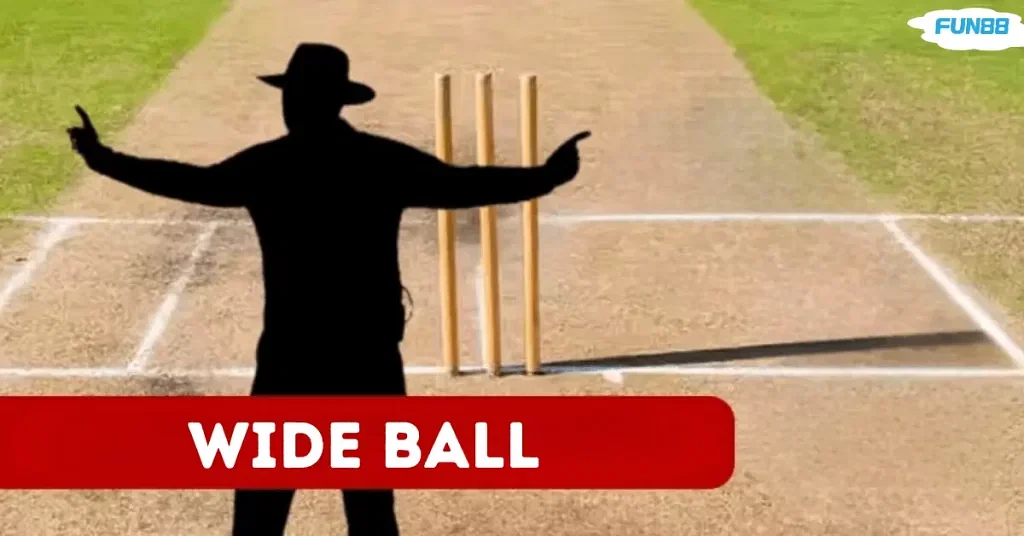A wide ball in cricket is an illegal delivery outside the reach of a batter. If a bowler delivers a wide ball, the batting team gets a bonus run, which is sort of a penalty for the fielding side for bowling the wide ball. However, the on-field umpire decides to declare a ball ‘wide.’ This decision is based on the umpire’s judgment and the batter’s initial stance and movement.
This write-up focuses on exploring the details of a wide ball, the rules and regulations around it and some controversies and interesting stuff related to it.
Judging A Wide Ball In Cricket
Law 22.1 of the MCC rules of cricket discusses judging a wide ball. According to the official rules, if the bowler delivers a ball that is not deemed a “No Ball,” the umpire will declare it a wide if the ball crosses wide of the position where the batter is positioned or has been positioned at any time after the ball became active for that delivery.
The concept of a wide ball goes beyond the simple distance from the batter. While location plays a crucial role, the ball’s trajectory is judged considering the batter’s “normal” batting stance. Even if a ball is quite far away, it wouldn’t be called a wide if it’s within reach for a batter standing in a regular position. The key lies in the batter’s ability to play the delivery, not just how far it lands from their current position.
Related Read: Dead Ball in Cricket: Rules and Their Types
Movement Doesn’t Always Negate a Wide
Batsmen often adjust their stance slightly based on the bowler’s delivery. However, if the ball were genuinely outside their reach in a normal stance, even attempting a shot after shuffling their feet wouldn’t necessarily negate the wide call. The umpire’s judgement plays a role here, determining whether the ball was wide before the batter’s movement.
The umpire signals a wide by extending both arms horizontally. Interestingly, while wides contribute to the batting team’s score, they aren’t counted as legitimate deliveries faced by the batter. This means the bowler still has the same number of balls remaining in their over despite the wide.
Types of Wide Ball in Cricket
Wide balls aren’t just about the ball missing the batter! Here’s a breakdown of the key factors that determine a wide:
Leg Side: A ball that goes behind the batter on their leg side even slightly without hitting them or the bat is wide. This ensures the batter has a fair chance to play the delivery.
Off Side: Similarly, deliveries that stray too far away from the batter’s reach on the offside (the side opposite their holding hand) are also called wides. Think of it as the bowler missing the target zone for a playable shot.
Bouncers: Balls delivered above the batter’s head while in a normal batting stance are often adjudged as wides. The batter shouldn’t be forced to play unreasonably high deliveries.
Counting Bouncers: The number of bouncers (deliveries above the head) also plays a role in wide calls, but it depends on the format of the game.
Test and ODI Cricket: Bowlers can bowl at least two bouncers per over. If they exceed this limit, it’s a no-ball, not a wide.
T20 Cricket: Here, bowlers are even more restricted, and they are allowed only one bouncer per over. Any additional high deliveries are automatically called no-balls.
Wide Ball in Different Formats of The Game
The regulations about wide deliveries may vary slightly depending on the format of cricket in play, and it makes sense that way as well.
In Test cricket, the standard law is applied, whereby the umpire assesses whether a batter could reasonably have made contact with the ball using a standard shot. However, the leg-side wide ball is given a huge margin in the game’s longer format.
This is because test match cricket is about patience and bowlers finding their rhythm in swing and seam. An extra run here or bowling an extra delivery will not matter that much as the match will be played for a period of 5 days.
However, the stakes are much higher in shorter formats of the game, such as One Day Internationals (ODIs) and T20-Twenty20 (T20) matches. Each delivery matters and has the potential to change the momentum of the game, so naturally, stricter measures are often enforced. You will see additional lines marked on the wicket to provide clearer guidelines for when a wide is to be called.
In recent years, as batsmen have adopted more inventive techniques and begun to move around the crease before a bowler delivers the ball, umpires have been instructed to use their discretion and take into account the batter’s position at the moment of delivery.
In the end, it all depends on the umpire’s judgment, and when there is judgment involved, there is always a scope for error, which causes controversy. Moreover, judgment also involves subjectivity, so a lot of social media debates regularly take place on wide balls, especially in T20 cricket.
What is the Importance of a Wide Ball in Cricket?
So, why is the wide ball even a point of discussion and what is its importance? Well, a wide ball or any illegal delivery holds utmost importance and you do not want to be a bowler delivering those in crunch situations or any point for that matter.
The wide ball not only gives an extra run to the batting side, but it also means that the particular delivery will have to be bowled again. This can help the batting team tremendously in pressure situations, and the momentum of the game can completely shift.
Moreover, if the ball is too wide and even the wicketkeeper misses it, it can go for a boundary.
This means the batting team got 5 extra runs (1 for wide plus 4 for boundary) without playing a ball. Even if it does not go for a boundary, the batsmen are free to run between the wickets.
Furthermore, the importance of the wide ball is that it prevents the bowler from bowling deliveries that are not playable because of the unreachability. For instance, it would be very difficult for a right-handed batter to hit a ball delivered wide of the leg stump. This makes the game unfair for the batters out there.
Is it Possible to Get out on a Wide Ball?
By now, you are well aware that a wide ball is an unacceptable delivery. One might think the batsmen cannot be dismissed on such a ball. However, this is where cricket starts to be fun and interesting, as it also gives equal opportunity to the bowlers.
A batter can be declared out even on a wide ball using these modes of dismissal:
Stumping, run-out, hit wicket, obstructing the field.
Often, spinners intentionally bowl a wide ball when they predict or see a batter stepping out of their crease so that they can get a wicket by stumping them.
Also Read: What is a Dot Ball in Cricket? Explanation and Importance
Controversy Surrounding Wide Ball
When the batter moves around the crease, they take full advantage of the pitch. In this case, the bowler might purposely throw a ball wide off-stump to follow or surprise them. In this case, the umpires present in the field take the final call regarding the legality of the delivery.
Obviously, in close calls, the team which did not get a favourable decision will not be happy. We have seen many such instances where wide balls have caused a hell lot of difference and have even been influential in changing the results of the game. In cases like these, the wide ball becomes a topic of debate.
Many fans have suggested that just like a no-ball, a wide ball too must now be judged and called by the third umpire. However, this will once again negatively impact the role and the importance of the on-field umpire.
Conclusion
So, we have learned all the details, rules, regulations, and criteria for a wide ball in cricket. Obviously, the importance and relevance of a delivery like this change according to the format of the game and the situation of the match too. The tighter the things are, the more interesting they get.
Star it if you find it helpful.

